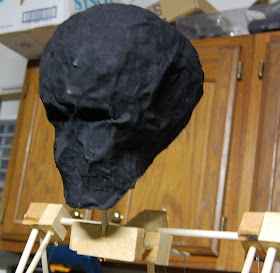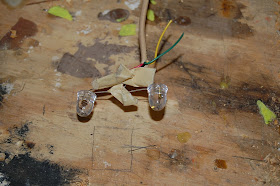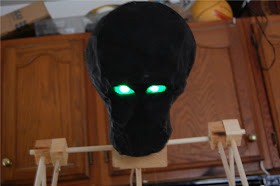
Click Here for Detailed How-to
This blog entry describes the construction of my wall breaker ghost. It is a cheese cloth ghost with 7 movements controlled by a single salvaged reindeer motor. The following videos show the ghost in action in UV and LED spot lights:
Moving Form
Form Construction. The moving form is centered on an A/C gear motor salvaged from an animated reindeer. The motor is mounted on a small piece of plywood using the screws that originally mounted a control arm to the motor. Then the plywood was framed with some scrap 2x4’s, this adds support and also provides a convenient place to attach the eye hooks that feed off the motor. EVERY line that comes off the motor FIRST goes through one of the eyes hooks in the 2x4s that encircle the motor, as seen below. I drilled several small holes around the edge of a 3/8” washer, filed off any sharp edges from the drilling, and then put the washer on the end of the control arm of the deer motor. The washer is held in place with a cotter pin (i.e. a piece of paper clip through the hole with the ends bent up).

Next step was to add all the moving parts. The key was to do it one movement at a time, using small eye hooks to guide fishing line back to the deer motor. Each movement was designed so that gravity would pull it one way, and the string attached to the motor will pull it the other way. All of the moving joints are simply scrap pieces of 2x4 with a hole drilled through it that will hold the dowel in place and allow it spin. All none moving joints are holes drilled in a 2x4 scrap, and the dowels glued in the hole. The whole process was very similar to building things with tinker toys (if you happen to remember those). When routing the fishing line from the motor to the movement, try to place eye hooks at points where you have a moving joint, this will keep the movement of one part from affecting another. For example, you will see a lot of eye hooks at the main torso joint, which the first moving point you get to from the motor.

Torso: this was the easiest movement, but it also takes most of the weight. I had to cut the original one out and redo it later in the project. Be careful that the moving dowel fits snuggly but still moves, I drilled it exactly 3/8” (for a 3/8” dowel), then used sand paper in the hole until the dowel fit just right. I also did not glue this dowel into place, making it easier to take apart if needed. A dowel coming out of the bottom of the torso joint controls the leaning in and out motion. In the picture below you will see where the lines comes from the motor, through an eye hook then back to an eye hook attached to this dowel. You will also see how I added a scrap 2x4 to support the torso joint at the bottom.

Head Up/Down: The second movement I built. I modified this later to add a turning head as seen in the image below, but the turning head did not change the way the head up/down works. The original head up/down is shown in the video below. A block mounted A line from the motor, through an eye hook at the torso joint will pull on the lever in the back, causing the head (which will eventually be mounted on the larger piece of 2x4 at the front of this movement) to go up. Notice how the head will only go down so far before it gets stopped by the shoulder (the next movement added)

The following video shows the torso lean and head up and down movement. You should note the single eye hook on the side of the torso joint, the guides the line for the head up/down.
Shoulders: Next I mounted the shoulders and upper arms. The supports for the shoulders (collar bones?) come off each side of the block at the top of the torso. The end of the collar bones have a block glued to them that holds a dowel that points down and forward from the shoulder. A line that is routed from the motor, through eyehooks at the torso joint, head joint, shoulder joint, then through this control arm will pull the upper arm up when the line tightens.

This video shows the form with the shoulder movement added. You start to notice the movement getting a little jerky, this is the first sign the first torso joint I made was too lose. The blocks half way along the collar bones are just temporary repairs as I adjusted the angle of the control arm that pulls the upper arms up. Once I had this right I replace with new dowels. One note, it is very simple to modify this type of form construction, simply cut off the old dowel flush with the block, re-drill the hole you want then remount the dowel.
Lower Arms: The lower arms are similar to the upper arms; a block is added to the end of the upper arm with a control arm that will hold a line that raises the lower arm when tightened. The cardboard you see is from a later step where I used card board to cover some of the dowels before applying the black cloth.

The following video shows the form with the lower arms added.
Head Turning.
Later in the build when I was ready to add black cloth to the forms, it was suggested that I make the head turn. I barely had enough in the budget to do this. So I did. I replaced the block that held the ‘neck’ with a slightly large piece I could drill a 3/8” hole in. The ‘neck’ sits in this hole, held in place by a 3/8 washer. A small hole was drilled in the dowel for a piece of paper clip to act as another kotter pin to hold the washer in place. Then an inverted T was added under the neck, and new eyebolts and line added that would move the head back and forth. This was the most complicated movement to add, requiring several tried and eye bolts to get it right.

A video later shows the head turning back and forth.
Head and Hands.
The head form was made with tape and newspaper. I initially made the head with a very large chin which I later cut off. Once the form was complete I used black cloth dipped in an elmer’s glue and water mix to ‘mache’ the head. As I have described earlier I find this technique and excellent way to build forms for cheese cloth ghosts. Once the cloth had dried, I cut up and removed the news paper from inside, then added a couple of cardboard braces. Once I had a good idea of my budget, I found I had enough to add some hot glue led eyes. I made the eyes in the form deep, cut a small hole in the back of them, and then hot glued a pair of green ultra bright LEDs so the light would shoot out of the eyes. I then filled the eye sockets with hot glue. It took 1 small stick to do the whole thing. A few feet of cheap telephone wire was run from the eyes to a 2 AA battery holder I could attach to the base. Instant glowing green eyes!




The hands were formed out with cardboard, newspaper and tape, and then covered in black cloth/Elmer’s glue/water. I used my own hands for dimensions, making the fingers longer. I added a small notch at the end of the arms, and a hole at the base of each hand. The hands hang freely from the ends of the arms.


The following video shows the ghost in action with the head and hands added. It also has the initial forms for the arms and shoulders.
Black cloth and cheese cloth.
I made some simple cardboard form that could be attached to the dowels for the arms, back and chest area. I learned when making the Leer ghost that something needed to be added to the dowels where the cheese cloth would be draped, so this is my first attempt at using black cloth mache to do so. I added black cloth/Elmer’s glue/water to these forms. Once they were dried I put everything back together and trimmed where necessary so the pieces would not rub together.



Next I added the cheese cloth. The cheese cloth was soaked in ½ cup Purex laundry soap and water, the wrung out and hung to dry. This was done working with small pieces on the head and hands (about 3” square works best). I dumped half a bottle of Stiffen in a tuperwear container and thinned it a little with water. The cheese cloth is applied by dipping it in the Stiffen, squeezing out the excess, the carefully spreading it the piece back out and placing on the black cloth form. This causes all sorts of interesting patterns in the cheese cloth. I kept a container of water I could dip my fingers in occasionally when they got too sticky. For the larger forms I would use some 8” by 8” pieces of cheese cloth first, then follow up with the smaller 3” square pieces. This technique is described in past posts on this blog.
Next I added some cardboard to the back the form so the cheese cloth would not be straight and square where it appears to attach to the wall. I lightly spray painted the form with flat black spray paint. I had to restring everything after paint got on the fishing line. The final step was to drape the remaining cheese cloth over the form completing the appearance of a ghost.


